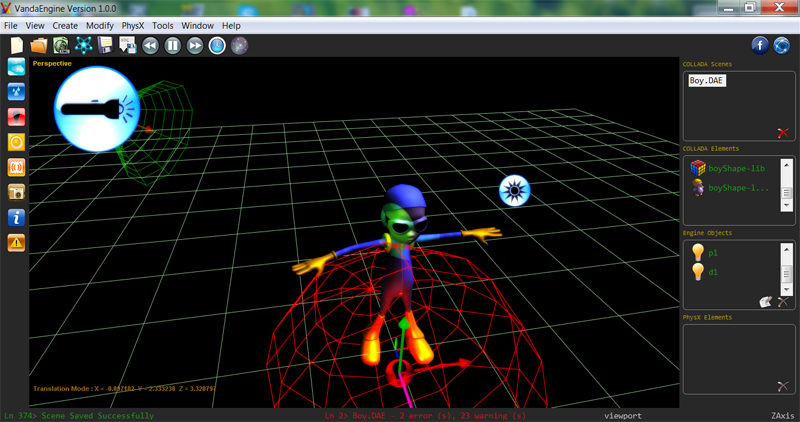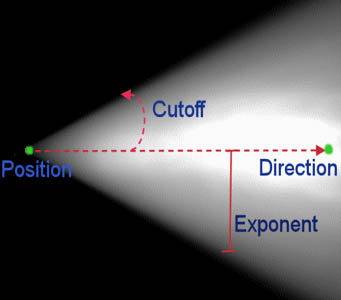To access the Light Editor, choose Create | Light... menu.
In This photo: A blue directional light, a green spot light, and a red point light.
Name
Lets you choose a unique name for this light
Light Type
Vanda Engine 1 supports three types of lights: directional light, point Light, and spot light.
· Directional lights affect everything in the scene, like the sun. Their position is irrelevant.
· Point lights shine from a location equally in all directions, like a light bulb.
· Spot lights shine from a point in a direction and only illuminate skins and instanced geometries within a cone - like the headlights of a car.
Ambient
Lets you specify the color of ambient property of the light. Ambient lighting is a general illumination that comes from all directions and equally brightens the scene.
Diffuse
Lets you specify the color of diffuse property of the light. The main difference between ambient light and diffuse light is the fact that diffuse light is dependent on the direction of the rays of light while ambient light ignores it completely. When only ambient light is present the entire scene is equally lit. Diffuse light makes the parts of instanced geometries and skins that face the light brighter than the parts that are opposite from it.
Specular
Lets you specify the color of specular property of the light. A specular highlight is the bright spot of light that appears on shiny instanced geometries and skins when illuminated.
Position/Direction
Lets you specify the position of point/spot light or specify the direction (voctor) of directional light.
Constant Attenuation
Mathematically, intensity of light is divided by constant attenuation (I = 1/ CA) where I is intensity and CA is constant attenuation. In this case, Intensity of the light will be totally unaffected by distance, continuing until it hits a surface, theoretically capable of illuminating an infinite area. This type of light can be seen from the sky (sunlight, moonlight and starlight), and other large and distant light sources.
Linear Attenuation
Mathematically, the decline of this type of light is linear, inversely proportional to the distance from the light source (I = 1/ (LA* d) where I is intensity, LA is linear attenuation and d is distance). This means that the light intensity will diminish at a fixed rate as it travels from its source.
Quadratic Attenuation
Mathematically, the attenuation of a quadratic light is exponential (quadratic), expressed as "I = 1/(QA * d^2)", meaning that the further the light travels from its source, the more it will be diminished. This creates a very sharp drop in light.
 A directional is not subject to linear or quadratic attenuation since it is at an infinite distance.
A directional is not subject to linear or quadratic attenuation since it is at an infinite distance.
Spot CutOff
Only available for spot light. This property specifies the light cone angle in degrees.
Spot Exponent
Only available for spot light. This property controls the amount of light falloff from the center of the spotlight
Spot Direction
Only available for spot light. This property specifies the direction (voctor) of spot light.
Spot Light






